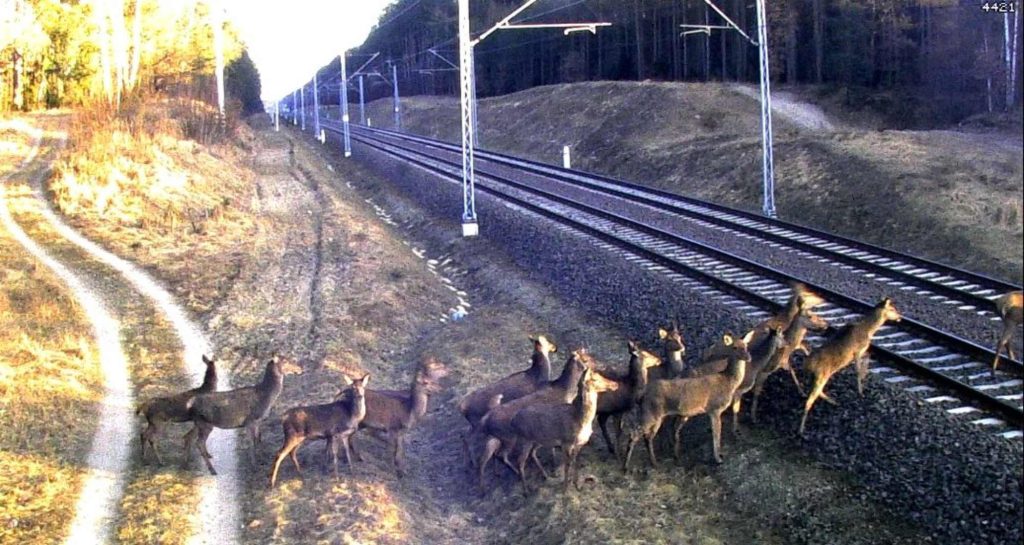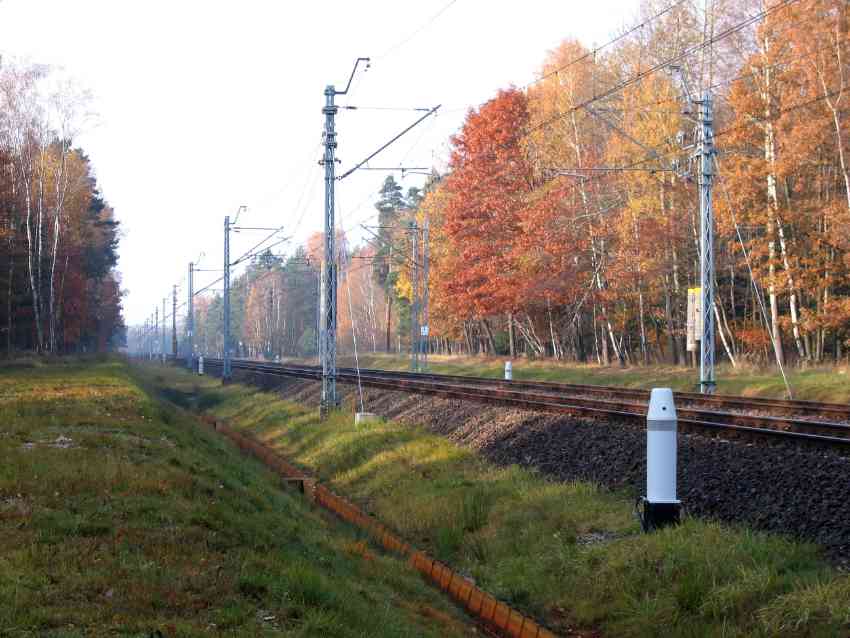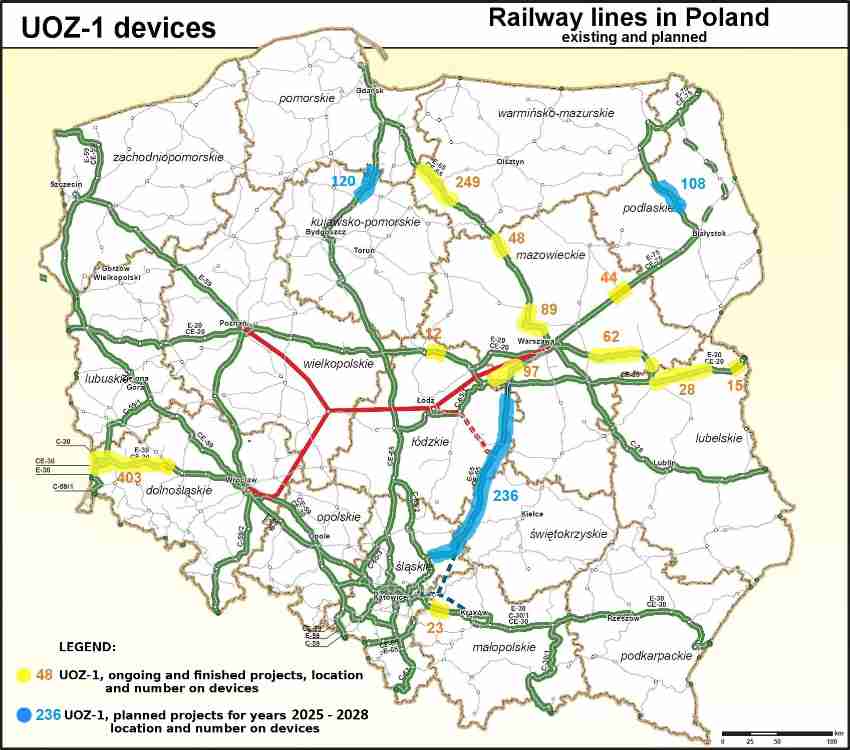Men tend to see railway lines as part of the transport infrastructure. For animals it is part of their environment, familiar, but potentially very dangerous. How to make animals aware that the collision with a train may cost their lives? We must warn them in their own language.
Most of the rail lines were built so long ago, that from the point of view of the animals they have always existed. They have a relatively little impact on the surrounding environment, however, pose a barrier to the movement of small creatures (like frogs and rodents) and the cause of death of a number of animals. Paradoxically, technological progress by raising passenger comfort increased animal mortality on the tracks. One of the reasons for this is higher train speed, second – better and better sound proofing of the railway line and protection against vibrations of the ground. Therefore, animals much later notice quickly and quietly oncoming trains.
Animal on the tracks
In the implementation of linear investments – including, among others, construction of railway lines – one cannot pass round all the valuable natural areas, and all the habitats of common animals. When the tracks run through the territories of animals, animals often cross tracks as part of their normal daily activities. On the other hand, species migrating over long distances overcome various obstacles along their way – including the tracks.
It also happens that the animals come to the vicinity of the railway line on purpose. In the spring, close surroundings of the railway line covered with fresh low vegetation can be a valuable pasture for herbivores. Omnivorous animals (foxes, wild boar) can come to the tracks in search of food debris thrown from trains and carrion. And in winter, when everything is covered with thick snow, tracks – which are cleared of snow – turn out to be the most convenient way of migration – especially wild boar like walking on the railway tracks, which unfortunately often ends tragically for the animals.

The barrier effects
Fragmentation of habitats and preventing migration of animals are a very serious threat to the environment. Free animal migration is essential for sustained existence of a population. Fencing transport routes often prevents the exchange of genes between populations on both sides of the road. This in turn leads to a decrease in the population condition, increase in susceptibility to diseases, and in extreme cases – extinction of the local population. Many species are functioning properly only when ecological corridors are preserved. The barrier effect has more serious consequences for the population than the mortality of animals killed by trains. For game species, it is many times lower than, for example, hunting tolls. However, in contrast to the hunters, the trains do not choose their victims and hence also representatives of rare protected species are killed on tracks. It is different when a fox dies on the tracks, and different when the victim is a moose. In case of endangered species, the death of every single individual is a serious loss for the population. It is therefore necessary to introduce effective protective measures, especially in areas where representatives of the valuable and protected species live.
When collisions occur mostly?
Responding in a single sentence: when railway lines intersect animal migration routes. The risk of collision with some species remains at the same level throughout the year, for other species there are periodic increases in mobility associated with the mating season and search for new territories. In case of herd animals reluctance to separate from the group is of great importance. If the leader of the herd decides to cross the tracks, other animals follow them. At the time that elapses between the first and the last animal crossing the tracks, a train can arrive. An animal determined to stick to the group, despite the dangers would risk running right in front of the train. Accidents occur also in cases when an animal is startled or, for example, chased by a predator – fleeing in panic it does not look around and the chance of running across the tracks straight onto approaching train is then greater.
The art of survival
The reactions of animals to various components of their environment are largely genetically determined. As a result, an animal can instinctively recognize danger, even if it comes across such a situation for the first time in its life. This mechanism causes that everything which reminds a predator raises strong anxiety. On the other hand, it allows to get used very quickly to these elements of the environment that do not resemble a predator and are not dangerous – for example, the presence of the railway tracks, traction poles… and trains passing with a roar. A train does not resemble a predator in any way – it does not look or smell like a predator, nor creeps like one. Travellers can often observe from the windows groups of roe deer grazing near the track – these animals know that a train passing at the distance around 5-10 metres away will not do them any harm.
The situation changes when an animal is on the tracks. Because in nature no predator can run at a constant speed of 60-80 km/h and higher, animals are not genetically “programmed” to escape danger that approaches so quickly. The oncoming train finally crosses the “safety zone”, which can be described as “the flight distance” – this is the distance at which the animal runs away from any approaching object. But in case of trains this distance is too small in relation to the speed and an animal on the tracks often reacts too late to escape successfully.
Train traffic safety
One should keep in mind that collisions with animals also pose a risk to the railway traffic safety – a frequent result of collision is damage to the locomotive, there are also known cases of derailment of trains as a result of colliding with a herd of animals (for example, a pack of wild boars, a flock of sheep). There is thus a convergence of interests between the needs of the environment (keeping the possibility of free migration of animals) and human safety (protection against the risk of collision).
Therefore, it is important to use devices protecting animals and improving traffic safety – devices that would prevent animals against staying on the tracks when the train is coming.
Preventing accidents
How can we prevent accidents involving animals? The easiest way is to fence the railway line so that no animal could enter the tracks. This method, however, despite being very effective in preventing accidents has serious negative consequences for the environment, because it causes its fragmentation. Natural scientists call for keeping the freedom of movement of animals. Therefore, fencing should always be accompanied by building special over- or under passages for animals, which are in turn very expensive. A better way is to warn animals about the danger and to cause them to leave the railway tracks before passage of a train. To effectively control the behaviour of animals, it is necessary to know their psychology – to understand the way of thinking of animals.
Animal protection devices
Animals only react to these images, sounds and smells of the surrounding world that have some meaning to them. A human voice message “Attention, danger!” is completely incomprehensible for animals. It has to be translated into the language of animals. Impossible? Not at all. Animal protection devices “UOZ-1” produced in Poland work this way. They use recorded animal voices indicating a potential or very close danger. Devices installed at the railway track for a short while before a train passage emit a sound sequence consisting of, among others, alarm cries of birds, voices of predators and screams of terrified (affected) animals. The whole is a sound spectacle depicting a situation in which a large predator chases and catches prey. This means a potential threat to a variety of animals, including hares, deer, wild boars and foxes, which they can lose their lives when meeting a predator. As a result, the animals move away to a safe distance from the sound source, i.e. from the tracks. When the train passes the devices, they fall silent, and the animals can safely return to the vicinity of the tracks.

How does it work?
On the basis of the information on train movement the devices calculate the time when the train will be passing the protected area and turn on for about a minute before. The complete warning sequence lasts for about a minute and is designed so that the message about the danger is understood by different animal species. The timidest ones flee beyond the reach of potential predators after the first sounds, others are firstly listening for a moment before they decide to depart to a safer place. A minute-long emission of signals is long enough for even slowest thinking animals to get off the tracks before the train arrives, and short enough so that during most of the day – when there are no trains on the route – the devices are silent and the animals can freely cross the tracks or graze near them.
Verification
The first devices of this kind were installed in Poland in 2004 i operate to this day. Currently, on the main railway lines of Poland approximately 1100 units operate. The maps below show both, currently operating devices and plans for future implementation.

For over a 12 year the UOZ-1 system has been protecting animals also in Russia on the high-speed line from St. Petersburg to Moscow to and to Helsinki. In 2022, the UOZ-1 system was launched on the Vilnius–Klaipeda line of the Lithuanian Railways, and long-term advanced tests on test railway sections are being carried out by the Japanese railways JR West and JR East. Many years of experience of operation confirmed the high effectiveness of the devices. It was also confirmed by the researchers. A five-year research carried out by the Warsaw University of Life Sciences has shown that animals properly understand the meaning of sound signals and react to them with anxiety and moving away from their source, hiding in high vegetation or with a quick flight. What is important, the animals do not get used to the applied natural signals, so that the effectiveness of devices remains high after many years of installation.
In conclusion, animal protection on railway lines is a multidimensional issue. Its components include protection of animal life, protection of continuity of the natural environment and the safety of railway traffic and people’s lives. Although animal-train collisions are much rarer than animal-car collisions, the effects of a single case can be much more serious and in extreme cases can cost lives of many people. Therefore, prevention of accidents is in the common interest of natural scientists and railway managers. Effective warning the animals against an oncoming train seems to be the best way to prevent accidents without simultaneously increasing negative impact of railway on nature.

